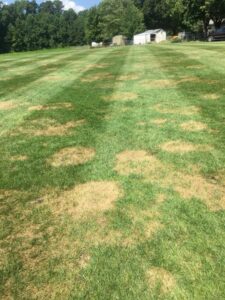Brown Patch of Fescue
go.ncsu.edu/readext?933860
en Español / em Português
El inglés es el idioma de control de esta página. En la medida en que haya algún conflicto entre la traducción al inglés y la traducción, el inglés prevalece.
Al hacer clic en el enlace de traducción se activa un servicio de traducción gratuito para convertir la página al español. Al igual que con cualquier traducción por Internet, la conversión no es sensible al contexto y puede que no traduzca el texto en su significado original. NC State Extension no garantiza la exactitud del texto traducido. Por favor, tenga en cuenta que algunas aplicaciones y/o servicios pueden no funcionar como se espera cuando se traducen.
Português
Inglês é o idioma de controle desta página. Na medida que haja algum conflito entre o texto original em Inglês e a tradução, o Inglês prevalece.
Ao clicar no link de tradução, um serviço gratuito de tradução será ativado para converter a página para o Português. Como em qualquer tradução pela internet, a conversão não é sensivel ao contexto e pode não ocorrer a tradução para o significado orginal. O serviço de Extensão da Carolina do Norte (NC State Extension) não garante a exatidão do texto traduzido. Por favor, observe que algumas funções ou serviços podem não funcionar como esperado após a tradução.
English
English is the controlling language of this page. To the extent there is any conflict between the English text and the translation, English controls.
Clicking on the translation link activates a free translation service to convert the page to Spanish. As with any Internet translation, the conversion is not context-sensitive and may not translate the text to its original meaning. NC State Extension does not guarantee the accuracy of the translated text. Please note that some applications and/or services may not function as expected when translated.
Collapse ▲While fescue is one of the best-adapted grasses to this area, it is not entirely problem-free. Hot, humid conditions in late spring create perfect growing conditions for a fungal pathogen called Rhizoctonia. This pathogen causes a common disease of fescue known as brown patch. Brown patch typically shows up in late spring and causes large brown patches in the turf that average around 4 inches to 3 feet in diameter. Individual leaves will show lesions. Cultural control is the best method of prevention. High nitrogen in the soil can promote brown patch, so it is best to limit nitrogen application to about half a pound per 1,000 square feet. Water turf only in the morning to allow excess water to evaporate. Remove thatch, the layer of dead leaf blades, to less than half an inch. Soil drainage is important, so consider aerating the soil when the threat of insect pests is low. If prevention doesn’t help, a fungicide can be used to treat affected areas. If brown patch is a recurring problem, consider reseeding with a different type of grass.

Brown patch lesions on fescue leaf





